As much as anything my discovery of these busts on the art uk website has prompted me to look at the 17th Century use of the type and variations of the socle seen on this pair of busts.
I have recently been looking at the socles used by John Cheere, Lous Francois Roubiliac, Joseph Wilton and Nollekens who all used distinct types of socles for their busts.
A series of notes and images!
A Female Plaster Bust Described as A Bust of Sappho.
Described on the website as 19th century.
H 74 x W 50 x D 22.5 cm.
I don't think this is either Sappho or 19th Century!
A possible clue here to its age is the form of the socle - which is related to several 17th century busts illustrated here particularly the bronze busts by le Sueur in the Royal Collection
The bust was stolen from Durham Castle in 1994, and only recently returned in 2017, after significant conservation and reconstruction work.
Images courtesy Art uk website.
https://artuk.org/discover/artworks/sappho-277056
Bust of Zeno of Elea, print by Jan de Bisschop, based on a
bust by an unknown artist, 1666 - 1671.
The bust of Plato in the Library of Trinity College Dublin has distinct similarities
https://bathartandarchitecture.blogspot.com/2016/12/bust-of-plato-in-long-room-trinity.html
_____________________
Two Seventeenth Century Bronze Busts of Venetia Lady Digby.
c. 1633.
This bust is inscribed by Larson.
By G (Guillaume or Willem) Larson (d.1660).
The most up to date study of the Larson family of Sculptors can be found in -
This can be found at the Jstor website -
http://www.jstor.org/stable/4150578
James Basire (1730 - 1802).
The sculptured bust at Gothurst; set on a decorative
pedestal with garlands of fruit and a plaque; illustration to Pennant's 'Tour
from Chester to London'. 1786.
https://www.britishmuseum.org/collection/object/P_G-7-175
For a later pen and ink copy by Moses Griffiths of this engraving see -
https://www.britishmuseum.org/collection/object/P_1948-0315-6-133
Gothurst Gayhurst was the family home of Sir Kenhulm Digby - it was sold by the Digbys in 1704 and bought by George Wright (d. 1724/5).
The only daughter of the 3rd George Wrighte, Anne Barbara,
born in 1784, died in 1830, unmarried. Gayhurst had been in the Wrighte family
for 126 years. Anne left the property to a distant cousin, George Thomas
Wyndham, whose young son died, leaving the property to his two aunts in 1837 -
Maria Anne Wyndham, who married Lord Macdonald of Slate, and Cecilia, who
married Lord Alfred Paget.
Owned by the Wyndhams from 1830 - occuped by Lord Carrington from 1842 - 1877.
The house was altered by William Burges for Lord Carrington
For a very useful history of Gothurst / Gayhurst see https://www.mkheritage.org.uk/sga/Gayhurst/gayhurst-owners.html
see (Rev. William) Coles' notes on Gothurst sent to Horace Walpole, c. 25 Sept 1762 referring to the portraits at Gothurst (Gayhurst).
"......Mr Wright supposed it might be Lady Venetia
Digby, but I could not discover the features of her in it, as represented in
that by Van Dyke, no more than in two very fine busts of copper gilt, or brass,
standing in Mr Wright's study, on two elegant pedestals of black and white
marble. It is by no means improbable but the bust put up for this lady by her
husband Sir Kenelm in Christ Church without Newgate in London was cast in the
same mould with one of these: that bust and monument were destroyed in the Fire
of London. One of these busts' is dressed in a loose and light habit, but in a
fine taste, and with her hair rather more flowing than the other, which is
frizzled out and curled, and ribbons behind; the figure is larger and fatter,
and is habited after the Van Dyke manner with a large laced handkerchief"
Horace Walpole in Anecdotes of Paintings in England: with
Some Account......
"Sir Kenelm erected for her a monument in black marble
with her bust in copper gilt, and a lofty epitaph, in Christ Church without
Newdate; but it was destroyed in the fire of London. Lodges Peerages of Ireland
vol IV p.89. There are two busts of Lady Venetia extant at Mr Wrights at
Gothurst in Buckinghamshire with several portraits of the family of Digby. The
house belonged to Sir Kenelm and was purchased
by Sir Nathan Wright ( the bust which was placed upon the sarcophagus is
said to have been extant, and seen by Mr Pennant( Journey to London)".
There is a passage in Athenae Oxoniensis by Anthony Wood
(1632 - 95)
"about 1676 or 5 as I was walking through Newgate
Street I sawe Dame Venetia's bust standing at a stall at the Golden Cross, a
braziers shop. I presently remembered it but a fire had got off the gilding:
but taking notice of it to one who was with me, I ncould never see it
afterwards exposed to the street. They melted it downe. How these curiosities
would be quite forgot, did not such idle fellows as I am put them downe".
This account is very close to that of John Aubrey (1626 -
97) in Brief Lives. Aubrey certainly aided Wood in the compilation of his work.
Extract above from John Aubrey - My own Life by Ruth Scurr.
pub. 2016. Lifted from Google Books.
John Aubrey, in Brief Lives in 1680 says -
"much against his mother's, etc., consent, he maried
that celebrated beautie and courtezane, Mrs. Venetia Stanley, whom Richard
earle of Dorset kept as his concubine, had children by her, and setled on her
an annuity of £500 per annum; which after Sir K. D. maried was unpayd by the
earle; and for which annuity Sir Kenelme sued the earle, after mariage, and
recovered it. He would say that a handsome lusty man that was discreet might
make a vertuose wife out of a brothell-house. This lady carried herselfe blamelessly,
yet (they say) he was jealous of her. She dyed suddenly, and hard-hearted
woemen would censure him severely.
After her death, to avoyd envy and scandall, he retired in
to Gresham Colledge at London, where he diverted himselfe with his chymistry,
and the professors' good conversation. He wore there a long mourning cloake, a
high crowned hatt, his beard unshorne, look't like a hermite, as signes of
sorrowe for his beloved wife, to whose memory he erected a sumptuouse monument,
now quite destroyed by the great conflagration. He stayed at the colledge two
or 3 yeares".
For Brief Lives, pub 1898 - vol I see -
https://archive.org/details/briefliveschiefl01aubruoft
Vol II -
https://archive.org/details/briefliveschiefl02aubruoft
..................................
Venetia Lady Digby.
The second bronze bust
Both busts in the sae private collection.
I am most grateful to the owners for allowing me access to the busts and for permission to use the photographs
....................................
Catherine Bruce, Mrs William Murray (d. 1649).
https://www.nationaltrustcollections.org.uk/object/1139887
..................................
A Pair of Plaster (not stone) Busts of Charles I and Charles II.
Collection of the Duke of Grafton. Euston Hall.
Images below from the Paul Mellon Photographic Archive.
The photograph above shows the bronzed plaster busts of Charles I and Charles II in
1965 at Hungershall Lodge, Tunbridge Wells, Kent, the home of the indefatigable researcher and English sculpture enthusiast Rupert Gunnis.
....................................
of Easton Neston Northamptonshire,
72cm., 28½in.; she 65.5cm., 25¾in.
Attributed to Peter Besnier (d. 1693).
The Sotheby's Catalogue entry for these busts follows below
-
"He wearing quirass with lions pauldrons and a sash tied on his right shoulder, his hair falling in locks over the breastplate, an old illegible paper label to the reverse; she facing slightly to dexter, her hair styled in deep curls about her bare upper chest and shoulders; each set on integral plaster socles bearing the date 1658.
The attribution rests on physiognomic and stylistic
comparisons as well as contextual evidence. The expressive modelling of the
heads with their animated features are more advanced than the work of Besnier’s
predecessor as Court Sculptor, Hubert Le Sueur, whose portraiture has been
rightly criticised for having a ‘curiously inflated appearance’. The angle of
the heads are more accentuated than the iconic frontality found in Le Sueur’s
busts. In their sense of movement they are much less mannered and the richly
modelled sash, drapery and hair - notably to the bust of Mary - imbue them with
a liveliness derived from the Italian Baroque.
In this connection one might at first think of two other sculptors active in Caroline England, namely the Italian, Francesco Fanelli (1577-after 1641) and the Fleming, Francois Dieussart (c.1600-1661).
Whinney,
who was the first to raise the possibility that Besnier may have been the
sculptor responsible for the Easton Neston busts, observed that they were
‘closer to the style of Dieussart’ (op.cit. p.440, note 2). There is no
specific comparison to be made in support this hypothesis, unless Whinney was
alluding to their advanced baroque naturalism: Dieussart was perhaps the most
talented of the foreign sculptors lured to London having spent the years
1622-1630 in Rome assimilating the latest developments in Baroque sculpture.
However Dieussart had departed for The Hague in 1641, well
before the Easton Neston busts could have been modelled, and the same year also
marks the last recorded reference to Fanelli in England.
It is Peter Besnier’s elder brother Isaac (active
1631-c.1642) who therefore provides the point of departure for a meaningful
stylistic comparison, and one that can be seen to reinforce Whinney’s initial,
if instinctive, placement of the busts in the Besnier orbit.
Isaac Besnier was first employed to look after the ‘Moulds,
Statues and Modells’ in the royal collection but his major sculptural
contribution is to be found in the realm of monumental tomb sculpture of the
1630’s. He collaborated with Le Sueur on the tombs of three of the greatest
personalities of the Caroline Court: that of the Earl of Portland in Winchester
Cathedral; and those of the Duke of Buckingham and the Duke of Richmond and
Lennox in Westiminster Abbey. While Le Sueur cast the figures and effigies in
bronze, Isaac carved the architectural marble components, including the
statuary and tablets. Indeed Lightbown credits him for a significant part of
their overall design. It is interesting
to hypothesise how the commission for the busts came about. Each portrait bears
the date 1658, an inauspicious time for sculptor and patron alike.
Sir William Fermor was the elder son of Sir Hatton Fermor
and his wife Anne Cockayne. At the
outbreak of the Civil War he and his younger brother Hatton joined the
King. William was created a baronet by
King Charles 1641: his younger brother was less fortunate dying for the
Royalist cause at Culham Bridge in 1645.
Sir Williams's marriage was very much a reflection of his loyalties. His wife Mary Perry was the widow of the Hon.
Henry Noel who had died a prisoner of the Parliamentarians. His brother Baptist
Viscourt Campden was a colonel in the Royal Horse Regiment.
During the years of the Interregnum Sir William had had to
compound for his estate and was under constant suspicion of agitation. In 1653
he was summoned before the council and in 1655 he was accused of killing the
Protector’s deer. In 1658, the year of his portrayal, he was publicly listed as
a Northamptonshire royalist without military rank. Besnier too suffered
hardship, having been deprived of his office of court sculptor, which he had
held since 1643, by the Parliamentarians. In his petition for reinstatement at
the Restoration, he claimed that he had fallen into ‘very great poverty and
want’ (see White op.cit.). However the evidence suggests the opposite was true.
In 1655 he was carving statues and shields for John Webb’s revisions to Lamport
Hall, Northamptonshire (not far from Easton Neston) and in the following year,
1656, he was working on his only signed and securely attributed work, the
monument to Sir Richard Shuckburgh, just across the border in Warwickshire.
These commissions, together with the present plaster busts, perhaps intended as
presentation models for finished bronzes, show that Besnier was not as close to
the ‘great poverty’ he claimed to be. If it was not his work at Lamport that
brought him to the attention of Sir William, it must have been owing to the
Shuckburgh monument that artist and patron became acquainted. Sir William’s
sister Katharine was married to Sir John Shuckburgh, Sir Richard’s son and heir
(see White op.cit., p.12), which provides a convenient avenue for their introduction.
Whinney, followed by White, attributes the posthumous
monument to Sir Hatton and Lady Fermor in St. Mary’s Church, Easton Neston, to
Peter Besnier. The memorial also commemorates Sir William, whose marble bust
appears between the two figures of his parents. This bust bears no relation to
the present plaster and is of a much inferior standard of execution. The
general design of the monument, with its three effigies of Sir Hatton’s
daughters arranged at the very top, recall his brother Isaac’s work of the 1630’s
for the Earl of Portland. The tablet inscription nonetheless dates it to 1662,
a year after Sir William’s death and at a time when Peter Besnier is documented
in London working in his court capacity at Old Somerset House.
I have not yet been able to locate a good photographs of
either of these monuments.
The paragraph below from British History online from - A
History of the County of Warwick: Volume 6, Knightlow Hundred. Originally
published by Victoria County History, London, 1951.
The south chapel (12 ft. 6 in. by 9 ft. 2 in.) is similar to
the one on the north. Against the east wall is a large marble memorial to
Richard Shuckburgh, died 1656. It has a classic pediment with the Shuckburgh
coat in the tympanum, surmounted by three urns, and below a portrait bust
flanked by angels with trumpets holding back curtains. Underneath there is a
carved panel with inscription, under a pediment of scrolls with a skull on
either side. It rests on a carved splay and a moulded base, with a block in the
centre of the moulding on which is placed a skull, below it the name Pet.
Bennier.
Entry below from The Biographical Dictionary of Sculptors
available online at -
Peter Besnier (Bennier) - A French sculptor and the brother
of Isaac Besnier, who had collaborated with Hubert le Sueur on the monument to
George Villiers, 1st Duke of Buckingham, erected in Westminster Abbey in 1634.
Peter Bennier may have been trained in France but was living in England before
October 1643, when he was appointed sculptor to King Charles I. He was required
to look after the ‘Moulds, Statues and Modells’ in the Royal collection, a duty
previously performed by his brother, in return for the use of a house and £50
pa from the privy purse.
The Civil War prevented him from taking up his duties and he
was deprived of his office during the Commonwealth. At the Restoration he
petitioned to be reinstated on the grounds that the late King had granted him
the ‘place of sculptor to His Majesty and the custody of his statues, etc, but
by reason of the most unhappy distraction befallen since, hee injoyed not the
same place, but was reduced into very great poverty and want through his
faithfulness and constancy’ (TNA SP 29/2, no 66-1, quoted by Faber 1926, 14).
His request was granted on 15 March 1661 (TNA, LC3/25, 113, cited by Gibson
1997 (1), 163) and he held the post until his death, when he was succeeded by
Caius Gabriel Cibber.
Bennier (Besnier) is listed as a ratepayer of Covent Garden, 1649-51,
and among the Ashburnham Papers is a reference to a tenement occupied by
Bennier near Common Street in 1664 (LMA, ACC/0524/045,046,047, 048, cited by
Gibson 1997 (1), 163).
The monument to Sir Hatton Fermor at Easton Neston, Northants, has been attributed to him because the bust is similar to the Shuckburgh one and the two families had intermarried.
In 1655 Bennier was employed at Lamport Hall, Northants,
carving shields and ‘pictures’, which were probably statues (Northants RO, IL
3956, cited by White 1999, 11, 12 n 10-11) (2). He also did unspecified work
for the crown at Somerset House in 1661-2.
Literary References: Gunnis 1968, 50; Colvin V, 1973-6, 255;
Whinney 1988, 90, 93, 439 n 16, n 21, 440 n 2-3; McEvansoneya 1993, 532-5;
Grove 3, 1996, 875 (Physick); White 1999, 11-12
................................
Anonymous Bronze Bust of a Lady.
Christie's, London, Ist July 1997 - lot 35.
The latter bust of Lady Digby is signed by Larson, who was
clearly an astounding metal caster, and displays an affinity to the work of Le
Sueur, but with less rigidity in the forms of the hair. This type of head can
also be paralleled among Van Dyck's English sitters.
.................................
Hubert Le Sueur - the Bronze Busts in the Royal Collection.
see -
https://www.rct.uk/collection/search#/page/2#who
Bronze Bust of Solon.
66.0 cm (including socle).
The text below lifted directly from the Royal Collection website.
Acquired by Charles I, c.1636–7. Invoice for £30 each reduced by Charles I to
£24 per bust.
St James’s Palace; ? sold in the Commonwealth sales of 1651; ? Whitehall Palace; Kensington Palace, King’s Library; twelve busts sent to Buckingham Palace, 1821; St James’s Palace; ten busts sent to Windsor Castle in 1834; Buckingham Palace, Lower Corridor (all twelve busts); Kensington Palace, Cupola Room; Hampton Court Palace,
One of a series of fifteen busts (twelve of which survive)
supplied to Charles I by Hubert Le Sueur. They can be characterised as
generalised or ‘improved’ copies of ancient busts rather than direct casts of
their various prototypes. The ancient prototypes were all in the Farnese
collection in Rome at the time the moulds were obtained in around 1635,
and today are in the Museo
Archaeologico, Naples.
In many cases the proportions of the busts and the
arrangement of drapery have been modified by the use of plaster, presumably in
the interest of creating a uniform series from a disparate set of originals.The
variations between Le Sueur’s busts and their ancient prototypes were necessary
because his task was to make a set from a group of heads that were not
themselves made by the same sculptor or strictly in the same style. In
addition, the ancient marble busts were not the only source available to him.
Engravings of at least six of the busts were published in Ioannes Faber’s
compendium Illustrium Imagines exantiquis marmoribus of 1606 based on the
Imagines et elogia virorum illustrium et eruditor (1570) by Fulvio Orsini,
librarian to the Farnese, a pioneering and influential study of ancient
iconography.
Nine of the twelve busts are wrongly identified by the
labels on their socles. In some cases this may result from the detachment and
re-attachment of the socles during one of their many movements, but it is
equally likely that neither Le Sueur nor the writer of the inscriptions knew
who the busts represented.
Le Sueur’s busts are probably the earliest surviving example
in Britain of a set of heads of ancient ‘philosophers’, a term that embraced
also historians, poets and orators. Such sets can be found in a number of
continental palaces from the early seventeenth century. For example, seven
bronze heads (called Seneca, Solon, Marcellus, Diogenes, Plato, Socrates and
Demosthenes), described a ‘cast after the antique,’ were listed in 1643 in the
petite Galerie of Cardinal Richelieu’s palace in in Paris, and a series of
bronze philosophers was also included in the posthumous inventory of the
collection of his successor Cardinal Jules Mazarin (1602–61). A group of four
bronze busts derived from the same Farnese prototypes (and more faithful to
them), which are thought to date from the early seventeenth century, were in
the ducal collections at Braunschweig. Perhaps of most relevance here is the
set of nine bronze heads of ‘philosophers’ listed in the posthumous inventory
of the Paris hôtel of Louis Phélypeaux de la Vrillière (1598–1681). Although we
do not know their identities, it is perhaps significant that de la Vrillière
became an important patron of Hubert Le Sueur following his return to France in
1641. The fashion for series of busts of this kind, some of which mixed ancient
and modern celebrities, hit Britain more generally in the early eighteenth
century.
Charles I.
Hubert Le Sueur.
Victoria and Albert Museum.
Probably made for Charles I; other bronze versions are
known. Carved in London by Hubert Le Sueur (born in Paris, about 1590, died
there after 1658). Stated at the time of purchase to have come from The Hague,
and stated to have been formerly in the royal palace Huis ten Bosch. Purchased
from Durlacher Bros., 42 New Bond Street in 1910.
https://collections.vam.ac.uk/item/O77800/charles-i-bust-le-sueur-hubert/
Here the bust has the typical Le Sueur Socle as used on the bronzes in the Royal Collection
But the back of the socle with the date 1631 is very similar to the socles on the busts of Lord and Lady Pomfret
......................................
Bust of Elizabeth, Queen of Bohemia. Marble, circa 1641 CE.
By Francois Dieussart. From the Dutch Republic, Now the Netherlands.
The
Victoria and Albert Museum












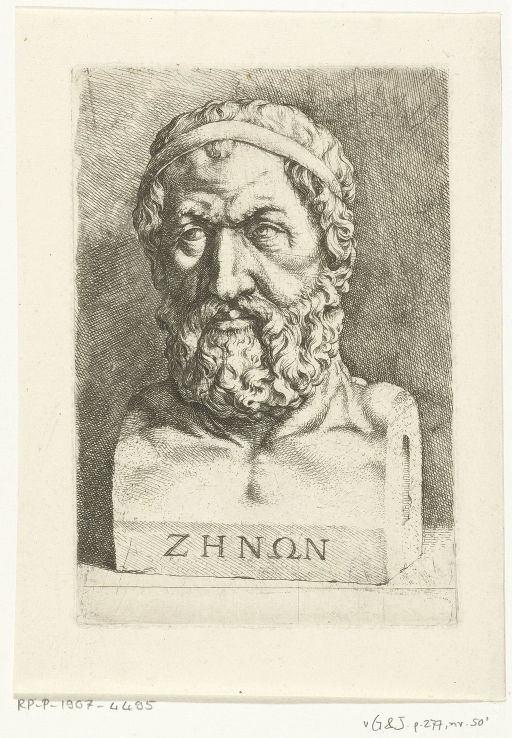





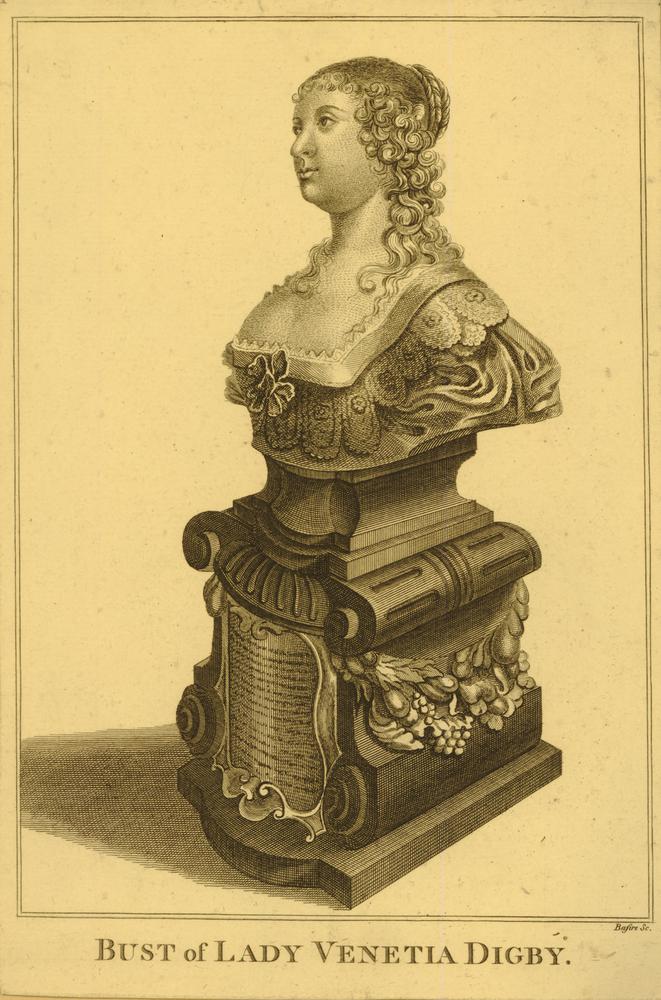.jpg)







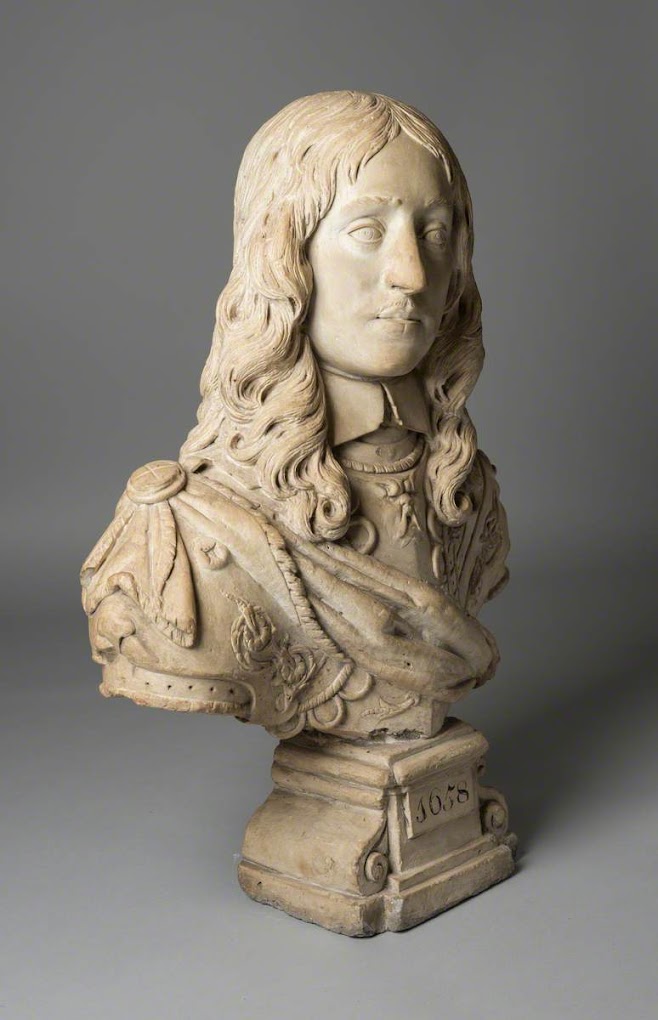








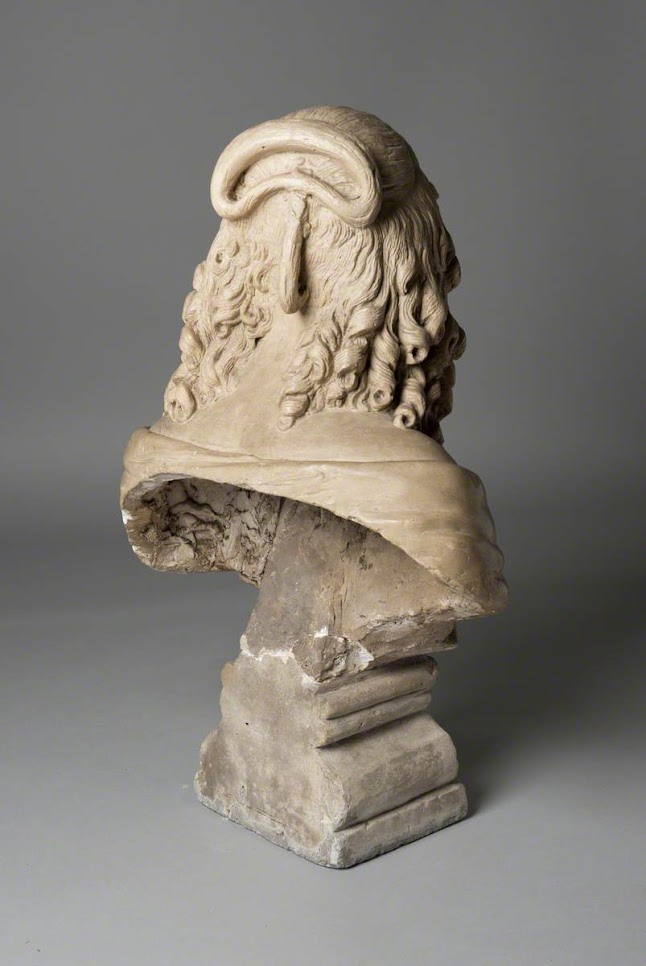




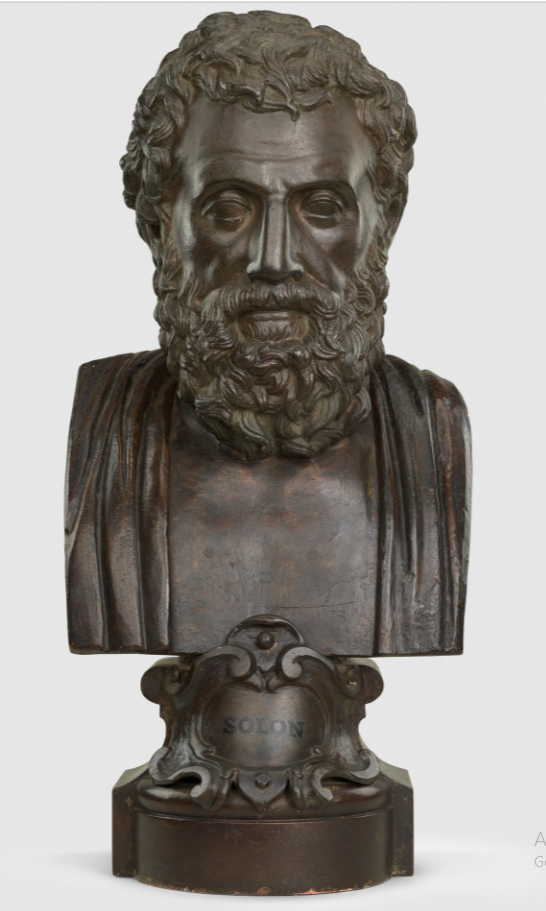



No comments:
Post a Comment